
Learn about the City of Toronto flag, the city’s Coat of Arms and motto, the Mayor’s Chain of Office, Toronto’s Official Tree and Toronto’s Official Bee.
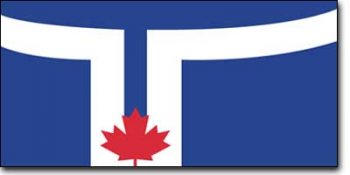
The City Hall symbol is incorporated in the flag design as an abstracted white linear graphic against a predominant blue (Pantone 287) background. A red (Pantone 186) maple leaf visually links Toronto to Canada and Ontario’s heritage, flag and symbols.
The flag dimensions are based upon a 2:1 ratio proportion.
You can download and print your own City of Toronto flag or City of Toronto flag colouring sheet.
The City of Toronto encourages residents, businesses, organizations, and institutions to fly the flag of the City of Toronto (Toronto Flag). Flying the Toronto Flag does not imply approval or collaboration by the City of Toronto for a project, product, or company.
Requests to use or depict the Toronto Flag for commercial uses, other than flying the Toronto Flag, require the City’s permission. Requests can be sent to protocol@toronto.ca.
A competition open to residents of Metro Toronto of all ages was launched in September 1974. A $500 Canada Savings Bond was the prize for the winning designer. More than 700 submissions were received from residents ranging in age from six to 90 years of age. The designs were varied in colour and theme – some included Toronto landmarks like the CN Tower and City Hall. Almost half of the designs incorporated the maple leaf while others focused on friendship and unity.
|
|
|
The flag design competition review, led by City Archivist Robert Woadden, was committed to maintaining a level playing field. He locked the proposed designs in the City Hall basement vault until judging took place on October 28 and 29, 1974.
After judging all submissions, the Flag Design Committee submitted its selection to Council on November 6, 1974. Unanimously, Council selected the design of 21-year-old George Brown College graphic design student, Renato (Rene) De Santis. De Santis’ design included the letter ‘T’ for Toronto, the outline of City Hall on a blue background and a red maple leaf representing the Council Chamber at the base of the towers. The original flag dimensions (or ratio) was 4′ x 6′.
An official flag raising ceremony was held on Nathan Phillips Square on November 7, 1974.
With the amalgamation of the Cities of Etobicoke, Scarborough, North York, York and Toronto, the Borough of East York and Metropolitan Toronto on

January 1, 1998, a second design competition was launched in 1997 to find a flag for the new City of Toronto. The public was invited to submit designs for a new flag but had to follow more specific criteria, such as limiting designs to three colours and 3′ x 6′ proportions. The prize for the winning design of the new Toronto flag was a $3,000 honorarium.
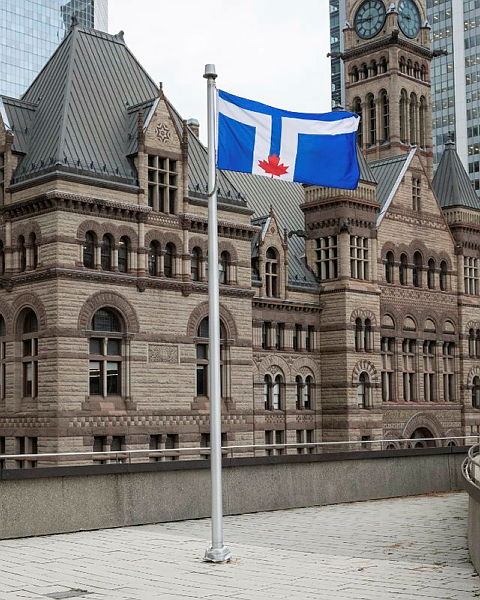
Council did not select any of the 161 design submissions received, nor did they select any of the staff designs. The designer of the original Toronto flag, Renato De Santis, suggested his design be approved as the official flag of the new City of Toronto, to fit the 3′ x 6′ format. At a Council meeting in November 1999, after months of debate, Deputy Mayor Case Ootes, who was chairing the meeting, polled the audience in the Council Chambers as to what design they liked best. The flag used by the former City of Toronto flag evoked cheers and whistles from the audience, clearly the favourite.
The modified design of the existing flag was adopted by Council as the flag of the newly amalgamated City of Toronto.
On November 7, 2024, 50 years to the date of the first hoisting of the flag at City Hall, a Toronto flag flew to commemorate the occasion. The following week, a flag raising ceremony took place prior to a Council meeting followed by recognition at the start of the the meeting to celebrate the 50th anniversary of the Toronto flag. Mayor Olivia Chow presented Renato (Rene) DeSantis, the designer of the original flag, with the flag that had flown at City Hall on the anniversary date.
Several other activities took place to recognize the 50th anniversary of the Toronto flag, including: distributing flag materials and sending resource links to schools to promote curriculum alignment; displaying the Toronto flag decal on City fleet vehicles; distributing paper flags during City Hall educational tours; and making special flag cookies to mark the anniversary.
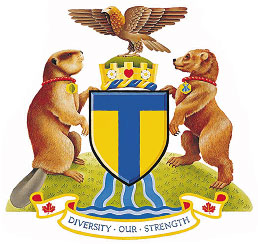 The Toronto Coat of Arms is an official symbol of the City of Toronto.Use of the Coat of Arms on stationery and other items is restricted to the Mayor and Members of Council and as authorized by Strategic Protocol & External Relations.
The Toronto Coat of Arms is an official symbol of the City of Toronto.Use of the Coat of Arms on stationery and other items is restricted to the Mayor and Members of Council and as authorized by Strategic Protocol & External Relations.
The arms were officially granted by the Chief Herald of Canada on January 11, 1999. City Council petitioned the Canadian Heraldic Authority for arms during their meeting that took place October 28 – 30, 1998 after a public consultation process.
The Arms are shown in Volume 3 of the Public Register of Arms, Flags and Badges of Canada. The official announcement was made by Letters Patent on July 22, 2000 as seen in Volume 134 of the Canada Gazette.
The Coat of Arms was created after the amalgamation of the former cities of Etobicoke, York, North York, Scarborough, Toronto, the Borough of East York and the Metro level of government.
How it was created
Meaning of each symbol: |
|
|---|---|
| The Shield: This represents the two towers of Toronto City Hall with the blue sky between and above the towers which form the capital letter T. | 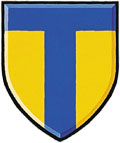 |
| The Eagle: The eagle, known for its strength, bravery and power, is a symbol used by the Mississauga of the New Credit First Nation and the Huron-Wendat Nation, on whose traditional territory the City of Toronto is now located. |  |
| The City Wall: The mural crown is a symbol of municipal authority. On the wall are a rose to represent the former City of York,(a York rose with green thorns), a heart for the former City of North York (for the “city with a heart”) and another rose for the former Borough of East York (also a York rose with a gold centre). |  |
| The Intertwining Collar: The collar symbolizes added strength when working together. This is where the motto “Diversity Our Strength” came from. | |
|
The Beaver: The beaver, a symbol of industry, has appeared on the coat of arms of the City of Toronto since 1834. The Green Grass: symbolizes the City’s proud legacy of many parks and recreational facilities. |
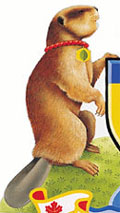 |
| The Honeycomb:This is a symbol of energy and productivity. It is hanging on the collar of the beaver in a gold hexagon shape.
The Green Alder-Leaf: This is a symbol of the former City of Etobicoke, which is an English derivation of the Ojibwa word “Wadopika” or “Wadopikang” meaning a “place where alder grow.” |
 |
| The Bear: The bear symbolizes strength, determination, caring and protection of its offspring. | 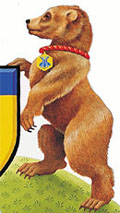 |
| The Columbine Flower: This flower is a symbol of the former City of Scarborough. It is hanging on the collar of the bear in the gold hexagon shape. The placement of the green alder-leaf and the columbine flower shows the geographic placement of Etobicoke on the west and Scarborough on the east. |  |
| The Three Rivers: The wavy bands at the base represent the Humber, Don and Rouge rivers flowing into Lake Ontario. |  |
Diversity Our Strength: This phrase refers to the multicultural dimension of the city and the seven municipal governments that now form the City of Toronto.

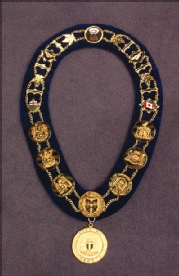
Civic regalia are a symbol of continuity, local identity and municipal pride. The chain of office represents the responsibility, authority and dignity of the office of Mayor.
For more than a thousand years, civic authorities have used an official seal incorporating the Coat of Arms to depict their authority and jurisdiction.
This seal was originally worn on a gold chain around the neck of the chief official. This “decoration” has evolved into the modern chain of office. Although decorative, the practice of wearing a chain of office is steeped in tradition, followed not only by municipalities, but by various other office holders such as the Crown’s representatives and parliamentary officials.
A modern chain of office is composed of symbolic elements joined together with pieces of chain from which a medallion is suspended. Chains of office may be sewn onto a velvet collar, which is not only decorative, but makes the chain more comfortable to wear.
When the City of Toronto was amalgamated in 1998, a new Chain of Office incorporated medallions from the six former cities and borough as well as Metro Toronto. The Toronto Mayoral Chain of Office includes the Coats of Arms or the shields of the following entities which existed pre-amalgamation (clockwise from top):
Suspended from the bottom front of the Chain of Office is a medallion displaying the Coat of Arms of the amalgamated City of Toronto.
On swearing in a new Mayor, the Chain of Office is symbolically placed around the Mayor’s neck and traditionally worn throughout the first meeting of the term for Toronto City Council. The Chain acknowledges the responsibilities, authority and dignity of the Chief Magistrate of Toronto.
The Mayor may wear the Chain of Office on ceremonial occasions when appearing in an official capacity representing the City such as Royal and Official visits and ceremonies, investitures, and when decorations are worn by other guests.
When not in use, the Chain of Office may be viewed in the display case located in the reception area of the Mayor’s office.
The Chains of Office of the pre-amalgamated municipalities are held by the City of Toronto.
The Oak Tree was designated Toronto’s Official Tree in Spring 2022, after City Council in December 15, 2021 authorized the selection on an official arboreal emblem for the City of Toronto, following public engagement.
Thousands of people voted in a competition to select a new official tree. The oak was chosen as Toronto’s official tree with the oak receiving 47 per cent, the maple 31 per cent, the birch tree 14 per cent, and the pine tree receiving eight per cent of the votes. A total of 11,000 votes were received.
Many orders of government both in Canada and around the world have named a type of tree as an official symbol. The City of Toronto has signalled the importance of trees to Toronto through multiple Council decisions and most recently through its commitment to TransformTO.
Trees have played a meaningful role in the historical development of Toronto from the origin of its name, to their use in commemorating events and people, including many of those who made the ultimate sacrifice in service during times of war in places like Coronation Park.
Trees provide a range of environmental, ecological, social, cultural and economic benefits and play a meaningful role in our city by absorbing water, cleaning the air, providing shade, reducing erosion, flooding and wind tunnels, and decreasing heating and cooling costs.
The selection an Official Tree that is a native tree species, easy to identify and found across Toronto helps raise awareness about our diverse urban forest while reaffirming our commitments to grow, enhance and protect it.
Characteristics:
How to identify an oak tree:
Ideal growing conditions:
Uses:
Where to find oak trees in Toronto:
Oak species native to Toronto:
More facts:
The Bicoloured Agapostemon (Agapostemon virescens) was declared Toronto’s Official Bee in 2018 to raise awareness about Toronto’s diverse native bee community and promote Toronto’s Pollinator Protection Strategy.
Toronto’s Official Bee was even featured on the TVO Kids episode Bees in the Meadow.
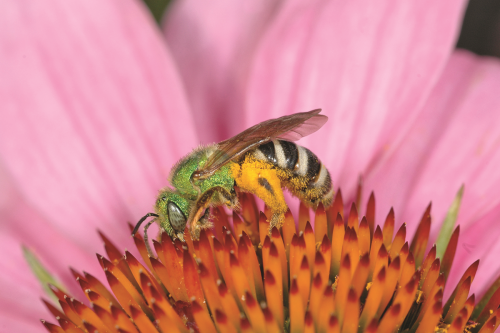
This metallic green sweat bee is: